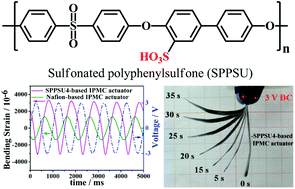The enhanced actuation response of an ionic polymer–metal composite actuator based on sulfonated polyphenylsulfone
Abstract
The sulfonated polyphenylsulfone (SPPSU) membranes with different degrees of sulfonation (DS) were prepared for fabricating low-cost and high-performance ionic polymer–metal composite (IPMC) actuators. The properties of SPPSU ion exchange membranes and the electromechanical performance of resulting SPPSU actuators can be manipulated by controlling their DS. As the DS of SPPSU membranes increases, their ion exchange capacity (IEC), water uptake and ion conductivity increase accordingly, whereas the hydrated mechanical properties (strength and modulus) decrease. The SPPSU membrane with the highest DS (SPPSU4) shows much higher IEC and water uptake, and slightly lower ion conductivity than those of the traditional Nafion membrane. Among the prepared IPMC actuators, the SPPSU4 actuator performs the best in the bending deformation under the electric stimulus. The maximum bending strain (MBS) of the SPPSU4 actuator is comparable to that of the Nafion actuator coupled with several times faster bending response at 3 V DC voltage. Compared with the Nafion system, the SPPSU4 actuator increases approximately twice at MBS under a sinusoidal voltage of 3 V at 1 Hz. This greatly enhanced actuation performance indicates that the SPPSU is a candidate to substitute Nafion in the field of IPMC actuators.


 Please wait while we load your content...
Please wait while we load your content...